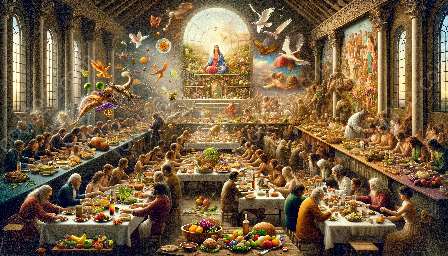From traditional dishes and cooking techniques to the social significance of meals, culinary traditions vary widely across cultures, offering insights into the social structures, food culture, and history of each region. Let's explore the rich and diverse world of food and its profound impact on societies around the globe.
Food and Social Structures
Food is not only a means of sustenance but also a reflection of social structures within a community. In many cultures, food plays a central role in social interaction, fostering a sense of community and belonging. From shared meals to elaborate feasts, food often serves as a vehicle for expressing cultural identities and strengthening social bonds.
Furthermore, the division of labor in food preparation and consumption can also shed light on the social hierarchy of a given society. In some cultures, certain dishes or cooking methods are reserved for specific social classes, highlighting the intricate relationship between food and social structures.
Food Culture and History
Exploring the food culture of different regions provides invaluable insights into their history, traditions, and values. Each dish and cooking technique carries a historical narrative, often rooted in centuries-old traditions and influenced by various historical events and cultural exchanges.
Moreover, the fusion of culinary traditions from diverse cultures has shaped the food landscape of many societies, giving rise to unique and vibrant food cultures. The evolution of food practices and preferences over time reflects the historical and cultural transformations that have taken place, offering a tangible link to the past.
Culinary Traditions Around the World
Italian Culinary Traditions
Italian cuisine is renowned for its regional diversity, with each region boasting its own culinary specialties and traditional dishes. From the rich pasta dishes of the south to the hearty risottos of the north, Italian culinary traditions are deeply rooted in the country's history and cultural heritage.
Japanese Culinary Traditions
Japanese cuisine is steeped in tradition and precision, with a strong emphasis on seasonal ingredients and meticulous preparation. The art of sushi-making, the delicate flavors of sashimi, and the comforting warmth of miso soup are just a few examples of Japan's culinary treasures.
Indian Culinary Traditions
Indian cuisine is as diverse as the country itself, with each region boasting its own distinctive flavors and cooking techniques. Spices play a central role in Indian cooking, adding depth and complexity to dishes that have been passed down through generations.
Mexican Culinary Traditions
Mexican cuisine is a vibrant tapestry of flavors, colors, and aromas, deeply influenced by the country's rich history and indigenous traditions. From the earthy warmth of mole sauce to the tangy freshness of ceviche, Mexican culinary traditions offer a tantalizing glimpse into the country's cultural heritage.
Conclusion
Culinary traditions in different cultures offer a window into the complex interplay of food, social structures, and history. By exploring the diverse and dynamic world of food across cultures, we gain a deeper appreciation for the profound ways in which food shapes and reflects the societies in which it is cultivated and consumed.

